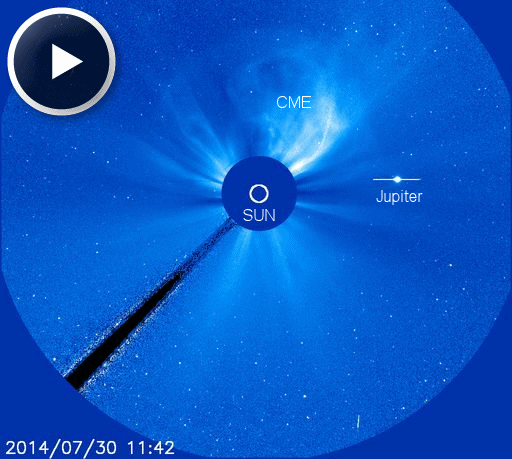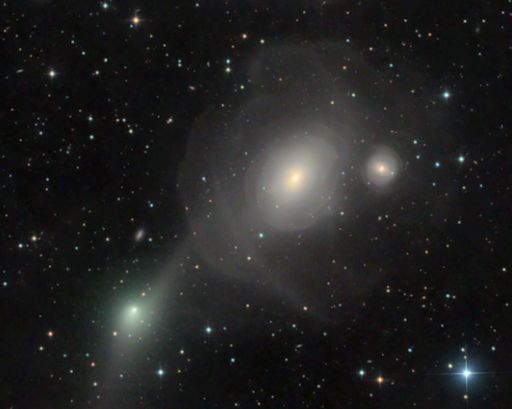New from Spaceweather.com: Edge of Space Advertising. Send your product or message to the edge of space for a down-to-Earth fee. Profits support student space weather research. Email Dr. Tony Phillips for more information. | | | DUE TODAY: NEW IMAGE OF THE ROSETTA COMET: The European Space Agency's Rosetta spacecraft is now less than 1600 km from Comet 67P/Churyumov-Gerasimenko. In only 6 days, Rosetta will reach the comet's core and go into orbit around it. A new high-resolution image of the comet is due to be released today. Look for it @ESA_Rosetta. INCOMING STORM CLOUD: Yesterday, July 30th, a dark magnetic filament on the sun erupted and hurled part of itself into space. The Solar and Heliospheric Observatory tracked a bright CME moving away from the blast site at 700 km/s: 
Although the CME is not coming straight for Earth, it does have an Earth-directed component. Computer models suggest it will deliver a glancing blow to Earth's magnetic field on August 2nd. NOAA forecasters estimate a 30% chance of polar geomagnetic storms when the storm cloud arrives. Aurora alerts: text, voice Realtime Space Weather Photo Gallery THE MARS COMET MEETS FORNAX A: On Oct. 19, 2014, Comet Siding Spring (C/2013 A1) will pass extremely close to Mars. For a while last year researchers thought the comet's core might strike the planet's surface. Now we know that it will be a near miss. Siding Spring will glide by Mars only 132,000 km away--about 1/3rd of the distance between Earth and the Moon. On July 28th, UK astrophotographer Damian Peach photographed the comet en route to Mars passing by the galaxy Fornax A: 
"This proved to be a rather fascinating conjunction due to the strange appearance of Fornax A," says Peach. "The various faint shells surrounding it are thought to have been caused by several galactic collisions in the remote past." Three months from now the comet will reach Mars. Although the comet's nucleus will not strike the planet, gas and dust spewing out of the comet's core will likely interact with the Martian atmosphere. There could be a meteor shower, auroras, and other effects that no one can predict. NASA's fleet of Mars spacecraft and rovers will record whatever happens. Amateur astronomers can monitor the comet's approach to Mars in the months ahead. Right now, Siding Spring is gliding through the southern constellation Fornax glowing about as brightly as a 12th magntitude star. Mid-sized telescopes such as the Comet Hunter equipped with CCD cameras should have no trouble picking it up. [light curve] [ephemeris] [3D orbit] Realtime Comet Photo Gallery
Realtime Meteor Photo Gallery
Realtime Aurora Photo Gallery
Realtime NLC Photo Gallery
Every night, a network of NASA all-sky cameras scans the skies above the United States for meteoritic fireballs. Automated software maintained by NASA's Meteoroid Environment Office calculates their orbits, velocity, penetration depth in Earth's atmosphere and many other characteristics. Daily results are presented here on Spaceweather.com. On Jul. 31, 2014, the network reported 19 fireballs.
(15 sporadics, 2 Southern delta Aquariids, 1 Perseid, 1 alpha Capricornid)  In this diagram of the inner solar system, all of the fireball orbits intersect at a single point--Earth. The orbits are color-coded by velocity, from slow (red) to fast (blue). [Larger image] [movies] Potentially Hazardous Asteroids ( PHAs) are space rocks larger than approximately 100m that can come closer to Earth than 0.05 AU. None of the known PHAs is on a collision course with our planet, although astronomers are finding new ones all the time. On July 31, 2014 there were potentially hazardous asteroids. Notes: LD means "Lunar Distance." 1 LD = 384,401 km, the distance between Earth and the Moon. 1 LD also equals 0.00256 AU. MAG is the visual magnitude of the asteroid on the date of closest approach. | | The official U.S. government space weather bureau | | | The first place to look for information about sundogs, pillars, rainbows and related phenomena. | | | Researchers call it a "Hubble for the sun." SDO is the most advanced solar observatory ever. | | | 3D views of the sun from NASA's Solar and Terrestrial Relations Observatory | | | Realtime and archival images of the Sun from SOHO. | | | from the NOAA Space Environment Center | | | the underlying science of space weather | | 
